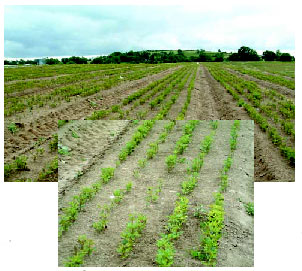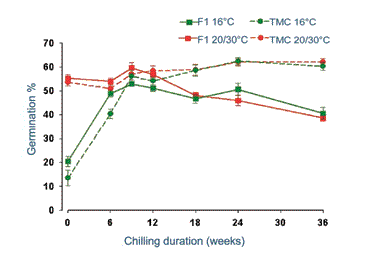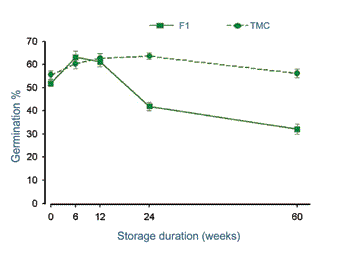 Figure 1. Poor and uneven seedling emergence in a bare-root nursery in Ireland.
There has been a large increase in the planting of broadleaf species in Ireland in recent years, especially native trees such as alder, ash and oak. Planting stock is produced in 'bare-root' nurseries, i.e. seedlings are grown outside in a nursery bed and then lifted and dispatched, bare of soil, for planting. However, poor germination in the nursery can cause significant losses at an early stage in the production cycle, thus reducing seedling yields (Figure 1). COFORD funded the QualiBroad research project, which was a collaborative effort between Coillte and UCD, to help address seed germination problems in important native broadleaf species.
Figure 1. Poor and uneven seedling emergence in a bare-root nursery in Ireland.
There has been a large increase in the planting of broadleaf species in Ireland in recent years, especially native trees such as alder, ash and oak. Planting stock is produced in 'bare-root' nurseries, i.e. seedlings are grown outside in a nursery bed and then lifted and dispatched, bare of soil, for planting. However, poor germination in the nursery can cause significant losses at an early stage in the production cycle, thus reducing seedling yields (Figure 1). COFORD funded the QualiBroad research project, which was a collaborative effort between Coillte and UCD, to help address seed germination problems in important native broadleaf species.
The seeds of most tree species become dormant, especially after being dried down to low moisture content levels to permit long-term storage. The standard method is to soak the seeds and then to chill them in a refrigerator for a few weeks in the fully imbibed (FI) state to break dormancy. The problem is that if sowing is delayed (e.g. by adverse weather), the seeds may germinate prematurely or deteriorate.
The results of the study showed that dormancy can be broken more effectively in these species using a lower target moisture content (TMC) method. This method involves adding a specific amount of water to the dry (ex storage) seeds to increase the moisture content to a specific level. The optimum moisture content to treat seeds of these species was determined in the preliminary experiments, after which the optimum chilling treatments were determined.
 Figure 2. Effect of prechilling duration on percentage germination of alder seeds at 150C and 20/300C. Treatments: Target moisture content (TMC) (discontinuous lines), and fully imbibed (FI) (continuous lines), seeds at the low (green lines) and high (red lines) germination temperatures.
Figure 2 shows the germination response of alder seeds at cool (15�C) and warm (20-30�C) conditions following various periods of chilling. Dormancy was expressed mainly at the lower temperature. The TMC seeds maintained good germination potential over long periods of chilling compared with the standard FI seeds. In addition, prechilled TMC seeds were held at -3�C for more than a year without affecting germination potential or re-introducing dormancy, whereas the standard-treated FI seeds began to deteriorate after about 12 weeks (Figure 3). Birch displayed a similar trend in response to these treatments.
Figure 2. Effect of prechilling duration on percentage germination of alder seeds at 150C and 20/300C. Treatments: Target moisture content (TMC) (discontinuous lines), and fully imbibed (FI) (continuous lines), seeds at the low (green lines) and high (red lines) germination temperatures.
Figure 2 shows the germination response of alder seeds at cool (15�C) and warm (20-30�C) conditions following various periods of chilling. Dormancy was expressed mainly at the lower temperature. The TMC seeds maintained good germination potential over long periods of chilling compared with the standard FI seeds. In addition, prechilled TMC seeds were held at -3�C for more than a year without affecting germination potential or re-introducing dormancy, whereas the standard-treated FI seeds began to deteriorate after about 12 weeks (Figure 3). Birch displayed a similar trend in response to these treatments.
 Figure 3. Percentage germination at 150C of alder seeds after storage at -30C for up to 60 weeks. See Fig 2 for other treatment details.
In conclusion, the TMC method gives much more flexibility in scheduling operations and will lead to significant improvements in plant yields in the nursery. Field trials in the nursery have confirmed the superiority of the TMC method.
Figure 3. Percentage germination at 150C of alder seeds after storage at -30C for up to 60 weeks. See Fig 2 for other treatment details.
In conclusion, the TMC method gives much more flexibility in scheduling operations and will lead to significant improvements in plant yields in the nursery. Field trials in the nursery have confirmed the superiority of the TMC method.
Contact: Dr Conor O'Reilly,
UCD School of Biology and Environmental Science,
UCD College of Life Sciences,
University College Dublin, Belfield, Dublin 4.
Phone: +353 1 716 7191.
E-mail:
[email protected]
|



